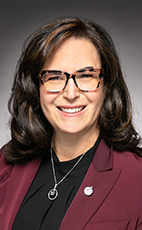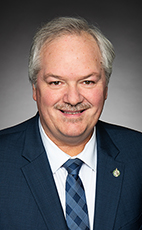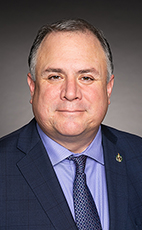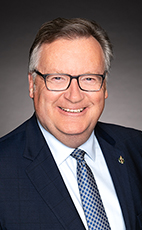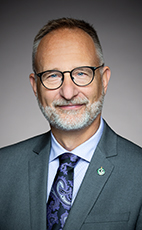44th Parl. 1st Sess.
May 9, 2024 10:00AM
- May/9/24 11:37:33 a.m.
- Watch
Mr. Speaker, the Bloc Québécois member did not listen to my speech today. I said it was a problem. The 2009 report that I mentioned states that the government has to start treating drug addiction like other chronic diseases.
43 words
- Hear!
- Rabble!
- add
- star_border
- share
- May/9/24 11:38:10 a.m.
- Watch
Mr. Speaker, I will be sharing my time today with the member for Thunder Bay—Superior North.
I rise today for the families of loved ones, who have lost the people most precious to them due to an overdose. I rise for the parents I have spoken to who have lost children and for the neighbours who have lost friends. I rise for those whose stories I have heard from across this country, people with lived and living experience, and for the many advocates I have met with who are called to do this work on the front lines and who fight against this crisis each and every day. I think of the mothers who have taught me that harm reduction and health care belong to all of us, everywhere, that people who are dead cannot recover or get into treatment, and that together we can make a change.
Each of these conversations has highlighted that a full spectrum of health services, including harm reduction is needed to meet people where they are, with dignity and compassionate care. These are the voices that drive our fight to save lives. Sharing these voices is our job as parliamentarians. To do that, we need to listen to them.
However, the Leader of the Opposition refused and continues to refuse to even meet with or learn from the many mothers, fathers, families and communities we need to listen to in order to better shape substance use policies. He is a leader who has weaponized and dehumanized our most vulnerable in society who need critical health care. He has done it to sow fear and to bring back the failed policies of the war-on-drugs era. This is not leadership.
We must look at the crisis, step into the eye of the storm that it is and do what needs to be done. We must use this moment and every tool we have at our disposal to fight the crisis, because doing nothing is not an option. The fact is that an ever-changing, ever more deadly toxic drug supply in the streets is killing our loved ones every day. It is the increase in fentanyl in the illegal supply that is driving the overdose crisis. This crisis is complex and all-pervasive. It leaves no community untouched. It cuts across ethnic groups, age, sex, geography and socio-economic status. Any plan forward must look at the full picture and see that there is no one-size-fits-all solution to meet this moment.
That is why, on this side of the House, we are guided by the renewed Canadian drugs and substances strategy to address the overdose crisis and other substance use harms. This is Canada's model. It is compassionate, comprehensive and person-centred. It is a holistic approach that balances health, social well-being and public safety. It recognizes that we need to keep doing more to help people and to keep our communities safe. This includes a full continuum of culturally appropriate and equitable supports and services for Canadians across the spectrum of prevention, harm reduction and treatment and recovery.
We need to place a high priority on children and youth, providing young people with the tools and supports to prevent, delay and lower the rates of their substance use. We want to curb substance use from the beginning and keep our communities safe.
With every policy and every program under the Canadian drugs and substances strategy, we consider potential risks and benefits through a public health lens and a public safety lens. We have also been prepared to adjust our approach as needed to reflect what is actually happening on the ground and what is working. Governing is deciding. Sometimes we may not get it right on the first try, but we owe it to those whom we serve and are trying to save to do everything we can.
We are working with partners to take action against criminal organizations that are trafficking and producing illegal drugs. We are leveraging all tools at our disposal to work toward an end to this national public health crisis. However, in this work, we have supported and will continue to support provinces and territories, indigenous communities and organizations so they can deliver the full suite of resources that are needed.
Building on historic health care investments, including those for mental health and substance use from last year, budget 2024 provides $150 million for a new emergency treatment fund for municipalities and indigenous communities to be able to respond rapidly to the emergent and critical needs related to this opioid crisis, such as in Belleville.
This commitment is in addition to the $1 billion we have directly invested to address this crisis, recognizing that all levels of government have a role to play to help Canadians and save lives. Collectively, the new investments we are making and funding will help provinces and territories expand the delivery of timely, quality and accessible mental health and substance use services across the country, as well as reduce harms, prevent overdoses, reduce stigma and save lives.
When it comes to substance use, our top priority continues to be protecting the health and well-being of people across Canada. To do that, we need an approach that puts health first while maintaining community safety, one that is compassionate, equitable, collaborative and based on evidence. The work of community-based organizations is a key part of this equation. Through the substance use and addictions program, we are supporting community organizations in delivering innovative prevention, harm reduction, treatment and recovery on the front lines and other evidence-based health interventions that are so desperately needed. These grassroots organizations have the trust of their communities and the first-hand knowledge needed to make a real difference in people's lives.
We know the main driver of the overdose crisis in Canada is the toxic and unpredictable illegal drug supply. It is contaminated by fentanyl. On any given day, it is likely that many people do not know what or how much they are even using. As a first step, we need to give people a chance to access the health and social services they need to improve their well-being. A dead person cannot recover.
The programs those in the opposition are against are health care. How can they be opposed to Canadians seeing a doctor? Why do they not trust doctors to make the best decisions in collaboration with their patients? People who use drugs are just that: people. They are not numbers, not props for a video. They are people who need our compassion. That is why we are pursuing an innovative and evidence-based harm reduction program, including supervised consumption sites, drug checking and naloxone. All of those tools are needed and so much more, because addressing this complex and evolving crisis requires us to continue to try new and innovative approaches. This is how we meet the moment to help save lives and better connect people who use substances to health and social services, health care for those who are ready.
Let me conclude with one very simple and straightforward principle. This is a public health crisis, not a criminal one. The Leader of the Opposition believed it at some point when he said, “opioid addiction is a disease and its victims are victims”, but victims have no place in prison. This is what advocates and experts remind us every single day. Our primary goal is to save lives and improve health while maintaining public safety. We need to reduce the barriers to health care, not build them up and perpetuate the stigma of criminalization.
I am proud of the comprehensive model that our government is advancing, one that helps reduce stigma and promotes access to a range of evidence-based services. Let us also talk about the bravery of the health care workers, the experts and frontline peer workers who are on the front lines every single day, meeting the moment and seeing who needs our help. We will continue to support their work and the work of the provinces, territories and other jurisdictions. We have to.
We will continue to support an approach that will help divert people away from using drugs, but also away from the criminal justice system and toward health and social services, because we cannot look away. We cannot put those who need our compassion and health care into forced treatment to become someone else's problem. It has never been more important for all levels of government to be working together because when people get the right support, there is hope and we can save lives.
1450 words
- Hear!
- Rabble!
- add
- star_border
- share
- May/9/24 11:47:51 a.m.
- Watch
Mr. Speaker, during my speech, I referenced Dr. Reyes-Smith and her attempt to provide the wraparound services that she felt her patients needed. I will note that she was one of the authors of the 2009 report I referenced as well. Dr. Reyes-Smith is a small business corporation, like every other doctor in the province of B.C. When doctors face their ability to operate, they have to work within a funding system that does not allow for wraparound care.
Why has the Government of Canada, with the $4.5 billion that it has not delivered on mental health yet, not tried to change that and allow for an innovative solution that allows a doctor in B.C. to provide wraparound services and treat the mental health addiction crisis more like primary care instead of a one-off visit with a patient?
144 words
- Hear!
- Rabble!
- add
- star_border
- share
- May/9/24 11:48:51 a.m.
- Watch
Mr. Speaker, I want to thank the hon. member for acknowledging that this is a health care crisis, as opposed to the Leader of the Opposition, who continues to dehumanize and criminalize those who need health care.
It is a great opportunity to highlight our comprehensive approach, which is a wraparound approach for addressing substance use in Canada. It is a four-pillar approach that includes prevention, harm reduction, treatment and enforcement, and also recovery. We recognize that meeting people where they are at, with a full suite of supports, with every tool at our disposal, is exactly what we are doing.
102 words
- Hear!
- Rabble!
- add
- star_border
- share
- May/9/24 11:49:34 a.m.
- Watch
Mr. Speaker, I was listening to the Conservative leader's response to one of my colleagues who was asking him to make the distinction between legalization, decriminalization and diversion. He said it was just semantics, that there was no real difference, that people just made up those distinctions depending on the context.
What does the minister think of the Conservative leader's ignorance?
63 words
- Hear!
- Rabble!
- add
- star_border
- share
- May/9/24 11:50:13 a.m.
- Watch
Mr. Speaker, this is exactly the point. The Leader of the Opposition and the party opposite create narratives that simply are not in the reality of what we need to be addressing right now. Decriminalization is about ensuring that someone who uses substances is not subject to prosecution. It does not legalize the many drugs that he listed. It means that we are opening a door for someone who is struggling to access health care, rather than stigmatizing them.
Why would we want to criminalize our loved ones? Why would we not want to get them into health care?
This is exactly why we have every tool available to us and we are working with jurisdictions to address this, because we need to meet people where they are and meet the moment to save lives.
135 words
- Hear!
- Rabble!
- add
- star_border
- share
- May/9/24 11:51:14 a.m.
- Watch
Mr. Speaker, 42,000 people have died from the toxic drug crisis, which is more than the Canadians who died in World War II. That is not meeting the moment. Spending less than 1% of what we spent in response to COVID-19 is not meeting the moment.
Portugal had over 1,000 people die from their drug crisis. It went from 250 people to 35,000 people on morphine in two years. It engaged the military and built labs. It built treatment centres so that people can get treatment on demand, year-long treatment. It spent money on recovery. Yes, it turned it into a health-based issue because it is a health issue, and it stopped criminalizing people.
The government says that it wants to integrate it and coordinate it, with a compassionate approach. Where is the plan? Where are the timelines? Where are the resources to get behind it? Why has the government not declared a national public health emergency? Why?
164 words
- Hear!
- Rabble!
- add
- star_border
- share
- May/9/24 11:52:12 a.m.
- Watch
Mr. Speaker, I want to thank the member for his continued advocacy and really collaborative work with us on this side of the House to address this moment that we are in and the toxic drug supply and the overdose crisis we are in.
We have made significant investments since 2016, a billion dollars toward this crisis. We have committed, in this budget alone, to have additional supports like the $150-million emergency treatment fund. We have signed bilateral agreements with every province and territory, with the key component being mental health and substance use, because health care is the way out of this. That is where provinces and jurisdictions come in to scale their health care systems.
118 words
- Hear!
- Rabble!
- add
- star_border
- share
- May/9/24 11:53:00 a.m.
- Watch
Mr. Speaker, I am really happy that we are having this debate because, today, I am thinking of so many loved ones across this country who are grieving the loss of their family member or friend, people like Carolyn Karle in Thunder Bay, who lost her daughter Dayna almost a year into her recovery. Dayna relapsed one night with alcohol. Then she took one dose of a substance that she thought was cocaine and tragically died of an opioid overdose later that night. That devastating loss left her mother determined to help others who struggle with substance use disorder, a condition that far too many of us know is chronic and reoccurring, but treatable.
Substance use-related disorder has been with us for a very long time. Opioid overdoses have been climbing over the past two decades, but since the pandemic, deaths have risen to an alarming 22 people a day. That is 22 circles of devastated friends and families a day. The drug crisis is marked by pain and a desperate need to do something. Easy solutions that sound like they are tough on crime have been found to do nothing to reduce harm and to save lives. We cannot incarcerate our way out of this pain and loss.
Unfortunately, today, we are debating a tired idea that has actually contributed to the ongoing crisis, an idea to starve out the problem, ignore any science and go back, way back, to a manner of talking about drugs that is harmful and ignorant, that will create more shame and disgust for substance users. The Conservative Party need not worry. I have yet to meet someone who uses substances problematically that is not already suffering from those feelings, and I have yet to meet a grieving parent who would not do anything at all to help their children see their value and reach towards recovery.
To treat substance use and reduce related harms for people and communities, there is no one silver bullet. In the early 2000s, I was the author of the Thunder Bay drug strategy. Through that work with treatment professionals, law enforcement, support workers and public health prevention experts, we came to model our strategy on the international research that says, to save lives and reduce harm to people and communities, we need to follow four pillars that work together: prevention, treatment, enforcement and harm reduction. Indeed, we added a fifth pillar of housing, as it became clear that a place to call home was the foundation of healing. I note that Conservative members have voted against housing approaches as well.
Last fall, our government launched the renewed Canada drugs and substances strategy, which offers a comprehensive, collaborative, compassionate and evidence-based drug policy. Using the advice of that strategy, informed by the cross-section of professionals, the Government of Canada announced over $1 billion in funding, including almost $600 million through Health Canada's substance use and addictions program. This supports frontline workers for treatment, harm reduction, prevention and to reduce stigma. That is money going directly to people and their families, so that they can heal. The money also funds research and surveillance initiatives and supports stronger law enforcement capacity to address illegal drug production and trafficking.
Substance use is a complex issue and Canadians use drugs for many reasons. Not everyone who uses drugs is suffering from an addiction. Indeed, many people who use drugs are sporadic users, which is why the toxic supply is so dangerous.
For people with addictions, the right kinds of treatment services may not be available or affordable. Barriers to treatment are often unseen. Some people face particular challenges, based on their own unique circumstances. Marginalized groups are often victims of stigmatization or prejudice, which places them at higher risk, including youth, indigenous peoples, racialized communities and LGBTQ+ people.
Putting one's hand up for help is very hard. Society still places huge judgment on people with addictions and throwing around words like “addict”, a word we have heard far too frequently from the Leader of the Opposition, actually continues that pattern of shaming. Shame is toxic too. It drives solitary use, silence and withdrawal from family and community.
Recovery looks different for everyone. I ask everyone in the House if they have ever struggled with a problematic substance or behaviour. Do they eat too much? Do they shop too much? Have they ever felt out of control with gambling? The list goes on. It is helpful for us to think of those times when we have been out of balance, because it gives us a glimpse into the “why” of addiction and empathy for the struggle to regain balance.
I can tell members that every person I have met who has lost a loved one would do anything to have another chance to keep that individual alive. There is no one-size-fits-all solution to this crisis. We need a range of supports that help, no matter if a person is using, contemplating how to get better or ready to step into recovery.
That is why harm reduction is so important, because we cannot treat someone if he or she is dead. Harm-reduction measures, such as supervised consumption sites and in-person or virtual spotting services, take-home naloxone and drug-checking technologies, keep people connected to services so they know they matter.
In 2016, there was only one supervised consumption site in Canada, and Stephen Harper tried over and over to shut it down. Thankfully, the courts agreed that the lives of drug users matter too.
Since then, our focus on saving lives means that we have approved 41 consumption sites in British Columbia, Alberta, Saskatchewan, Ontario and Quebec. At these sites, workers have prevented over 53,000 overdoses, with close to 4.5 million independent visits. That is a lot of people who want to live, but this motion says they are not worthy of that support, that they do not get another chance for a healthier day.
We also support a network of 45 treatment centres and services in the majority of first nations and Inuit communities across Canada: 82 sites that provide wraparound treatment and 75 mental wellness teams that serve 385 first nations and Inuit communities.
Although the Conservative opposition will tell people otherwise, harm reduction is actually treatment. When people feel seen and supported, they make connections. When people use a clean needle or inject a substance under the watch of a nurse, it means they want to live. At supervised consumption sites in Canada, there have been more than 424,000 referrals to health and social services. Harm reduction is a bridge to a better day.
The Leader of the Opposition wants to go back to the days of the war on drugs, but what he is actually proposing is a war on substance users, people and their families, people who suffer and people who hope for a brighter tomorrow.
Today, I say these words in defence of the families grieving the loss of their loved ones. I say it for the parents, like my dear friend Calvin Fors in Thunder Bay, who lost his young son to an accidental overdose; we remember Reilly. No more deaths like Reilly or Dayna, that has to be the focus. Compassion matters, evidence matters, connection matters and cruelty will not help people heal. It never has, and we have that evidence loud and clear.
1245 words
- Hear!
- Rabble!
- add
- star_border
- share
- May/9/24 12:01:03 p.m.
- Watch
Madam Speaker, the Minister of Mental Health and Addictions stated that the toxic drug supply was a leading cause of death. We agree with that. As the member noted, though, one of the four pillars is enforcement.
How many charges have been laid under the Criminal Code for the trafficking of fentanyl?
52 words
- Hear!
- Rabble!
- add
- star_border
- share
- May/9/24 12:01:30 p.m.
- Watch
Madam Speaker, I am extremely grateful to the law enforcement officers who work every single day with people who use substances. They are the hardest working members of a community, and we can all thank them.
In fact, I had an opportunity to go on a ride-along with law enforcement members just a couple years ago, and it was at Christmastime. Out of the 14 calls for help, 12 of them were for substance use-related disorder issues, including for alcoholism. These people were in the darkest moments of their days.
The law enforcement officers helped people and they connected them to mental health services. What they said repeatedly was that they needed a range of supports for people who were struggling in this way. It is heartbreaking work and people are doing it every day. I thank those enforcement officers.
142 words
- Hear!
- Rabble!
- add
- star_border
- share
- May/9/24 12:02:28 p.m.
- Watch
Madam Speaker, I commend my colleague. I was listening to her very emotional testimony. I support her and we are on the same page.
The opioid crisis is not a simple problem. This is a complex issue that deserves as much nuance as there are challenges and people having bad experiences when they use hard drugs. I think that the Conservative Party is in the habit of taking simplistic approaches to all sorts of topics. I think it is deplorable that, on this issue, they are taking such simplistic shortcuts as the ones that we are hearing.
I would like my colleague to tell us how she would respond to the public, who is anxiously waiting for us to provide all the tools available to stakeholders, so that we, in the House, can be part of the solution by voting against the motion. The motion is too simplistic and has too many Conservative shortcuts.
154 words
- Hear!
- Rabble!
- add
- star_border
- share
- May/9/24 12:04:00 p.m.
- Watch
Madam Speaker, far too many families and communities in this country are affected by this very sad situation.
I am glad the member asked what we could do. I am also glad for her call to vote against this motion. If we vote against the motion, we are telling those families that are struggling, doing anything to keep their loved ones alive to see another day, that they matter.
Every substance user in the country is connected to people. Those of us who have lived a life free of worrying about someone who uses substances are extremely blessed. It certainly is not me. There are many people in my life who I have watched suffer tremendously. Every single moment, we know that there is a brighter future if they could just hold on another day.
135 words
- Hear!
- Rabble!
- add
- star_border
- share
- May/9/24 12:04:58 p.m.
- Watch
Madam Speaker, the opioid crisis has devastated the James Bay region. We have had states of emergency declared. We have also had states of emergency declared on the health crisis and the suicide crisis. All the pillars of good health are essential.
I want to ask the minister about her decision to walk away from the Weeneebayko hospital. There have been 20 years of negotiations to have proper integrated health care in James Bay. I have spoken with Grand Chief Alvin Fiddler. I have spoken with Grand Chief Leo Friday. I have spoken with the national chief. They are all asking how the Liberal government could walk away from this project, which has been so many years in the making, to ensure we do not have third-class health care for the Cree people of James Bay.
137 words
- Hear!
- Rabble!
- add
- star_border
- share
- May/9/24 12:05:46 p.m.
- Watch
Madam Speaker, first, it will not only be health care that will get us out of this mess. It is building up community, which is the process of reconciliation. It is about equity and education. It is about better supports for people to reach their full potential, through the many ways we have delivered as a government.
I will refer directly to the member's question and say that I am not walking away from that commitment. We will get that hospital built.
83 words
- Hear!
- Rabble!
- add
- star_border
- share
- May/9/24 12:06:20 p.m.
- Watch
- Re: Bill C-5
Madam Speaker, in today's debate, we must not forget the over 42,000 people who have died. We must also not forget their families, who have suffered as they watched their loved ones get caught in a downward spiral. I want us to have a respectful debate, where we do not use people who are sick and suffering to further a political or ideological agenda.
I want us to work on solutions, while respecting frontline workers and hearing and listening to what they have to say. For some weeks now, at the Standing Committee on Health, we have been hearing from witnesses, experts, people who work with individuals who struggle with addiction. They have been telling us about the situation.
What we can say today is that substance abuse, multiple substance abuse, is not a simple problem, and it is not first and foremost a judicial problem. It is a severe and complex public health issue. I think everyone can agree, or at least I hope they can, that drug addiction is a very insidious, chronic and multifactorial illness.
At one time, it could be said of addicts that they were slowly making their way to hell. The introduction of a synthetic opioid, fentanyl, has now tragically reduced the length of that journey. That is why I think that, in 2024, we need to call it an illicit drug crisis. That is what is causing overdoses.
This is a complex issue, and simplistic solutions are not the answer. Between 50% and 70% of addictions are associated with primary mental health problems. People need better access to first-line treatment. I will get back to this later, but the lack of investments in health care is not helping. We cannot solve a problem, discuss a problem, find solutions to a problem or measure the effectiveness of these solutions without first agreeing on the concepts involved in addressing it.
I am totally stunned this morning. I always thought that the Conservatives and the Leader of the Opposition deliberately spoke in vague terms, that they wanted people to believe that all of the parties except theirs were in favour of legalizing hard drugs. That is no small thing.
If, on their criminology 101 exam, an applicant to the criminology department was asked the difference between legalization, decriminalization and diversion and they gave the answer the Conservative leader gave earlier, that they are all the same thing, that they are just synonyms, that we are using different words that mean the same thing, that person would be rejected.
How can anyone talk about a problem when they do not even understand the concepts needed to describe and discuss reality? There is no one in the House right now who thinks we should legalize hard drugs to deal with the illicit drug crisis.
The problem, as we will see later in the analysis of the Conservative motion put forth this morning, is that the concept of legalization is being used indiscriminately. Legalizing drugs leads to the commercial production of the substances in question. All drug-related offences are removed from the Criminal Code to allow people to use drugs. It could result in commercial production and sales and freedom of purchase and use, as was the case for cannabis. Can we agree that that is far from what we want?
Decriminalizing simple possession for personal use by an addict is not at all the same thing. Can we agree on that? If we cannot agree on that, where is this debate going? What are we talking about, exactly?
Decriminalizing drug use, and by extension avoiding making a person suffering from addiction go through the judicial process, is not the same thing as legalizing drugs. It is a way of destigmatizing the addiction and giving the addict, among other things, access to services and resources. For people to get to rehab, when that is what they want, we need to be in contact with them. If they are using drugs in secret, if they cannot talk about their addiction for fear of being stigmatized at work, does anyone think they will openly ask for help if they can be criminally charged? If they were unfortunate enough to take a pill from an illicit laboratory, they could die.
What people need to know is that this disease involves relapses, and no one ever wants to talk about that. People think all it takes is a stint in rehab and the problem is solved. That is not true, because relapse is part of the healing process.
It is a complex problem. Let us imagine managing to convince someone to go to rehab. Relapse is part of the process. Let us then imagine that that person no longer has access to supervised drug sites, which is what the Harper Conservatives proposed in 2011. The Supreme Court refused and said it was important because it would be injurious to the safety of people suffering from drug addictions. If a person relapses and no longer has access to these sites, they will take illicit drugs and will have less tolerance to the drug because opioids create a dependency. They could die. People talk about harm reduction, and those who work in the field say that supervised drug sites play an important role in harm reduction. Why is that? Because of illicit drugs. They can be tested to see if they contain fentanyl.
Of course, we need to deal with the issues arising from sharing spaces in the community. People who do not have a drug problem should not be left holding the bag. However, that does not negate an entire strategy based first and foremost, let us not forget, on prevention. It is not simply a matter of preventing drug use. It is also a question of preventing relapses, avoiding stigmatization and fostering social reintegration.
There is an incredible new project in my riding: a refurbished Uniatox. I am a little emotional. For the first time, this organization is going to work toward preventing relapses. There are not a lot of projects like that.
An utterly simplistic approach would be to stay away from harm reduction altogether. Just send people to detox, and then expect them to man up or woman up and deal with their life issues. This, however, is not the way to go. People will relapse. Supervised consumption sites do help people stabilize their drug use.
Harm reduction is one of the four pillars. I also talked about prevention. In this opioid crisis, a single pill can kill a person, so recriminalizing drugs will not solve the problem. That has absolutely nothing to do with it. I could go out on the street right now and get a black market pill. It has nothing to do with decriminalization.
There are a lot of overdoses in British Columbia, Alberta, Ontario and New Brunswick. Quebec does not have quite as many, according to the statistics I saw, but we have to be careful with that. Harm reduction also means safe supply. Why? Because we need to save lives, because illicit drugs kill. As far as I know, the fourth pillar, enforcement, is still not very effective.
In fact, for 50 years the repressive war on drugs approach solved nothing. If we compare the U.S. model to Portugal’s, we see that the United States is far behind. Still, is there a country more hostile to decriminalizing simple possession and more hostile to diversion? I have yet to speak about diversion, but that is what Bill C-5 called for, diversion measures.
To continue with the U.S.-Portugal comparison, Portugal had one million heroin addicts and a shocking public health problem surrounding HIV transmission. They decriminalized, but they did not put the cart before the horse. They did not simply ease their consciences by going the diversion route and standing pat. We must invest money, redouble support measures, and hire social workers, frontline workers and street workers. More controlled-supply centres are needed, and we must constantly adapt and course-correct.
I see people saying that the BC pilot project is terrible. It is indeed terrible, but is it the decriminalization that is terrible? No, it is the fact that they are facing a crisis that no one here would be able to solve with a snap of their fingers. Everyone needs to work together. Yes, the people in British Columbia need to make some changes, but decriminalization does not necessarily mean people can use wherever they want. This can be regulated. I imagine this is where they are headed. Furthermore, there can be no denying the problems of sharing spaces with the community.
I made myself a crib sheet about the legal pillar. We were taught this in criminology back in the day. At one end, there is criminalization. At the other end, there is legalization. That is a spectrum. On the criminalization side, there is the death penalty. Is there a more severe punishment than a death sentence? Then there is incarceration, followed by fines.
Next up, we slowly go into the diversion and decriminalization spectrum. This could involve supervised consumption, the possibility of diverting the person before the courts, targeted interventions by the police, formal cautions, administrative penalties and fines. There can be decriminalization of simple possession, which is not yet legalization. Next, there is regulation of retail sale and of commercial production, and then legalization. That is legalization. One can say that this constitutes a spectrum.
When I hear the opposition leader say it is all the same thing, I have to tell him no, it is not the same thing. There are tables available. A little reading would help. It is as though I said that the death penalty was the same as incarceration. No, there are different measures, there is differentiation within the decriminalization spectrum, including diversion measures. This is what Montreal and Quebec have gone with, diversion.
Bill C‑5 contained an important provision that included a diversion measure for simple possession offences. Among other things, it led to the implementation of the pilot project in British Columbia, which started in January 2023 and just ended. Has it really ended? The answer is yes and no, because I expect they are going to make the necessary adjustments.
For anyone who is unaware, this crisis has been growing since 2016 and spiked during the pandemic. Why? Because people were isolated then. When someone overdoses while they are alone, they cannot self-administer naloxone. Furthermore, unless people use in supervised consumption sites, they cannot get naloxone.
The motion is incorrect. Let us examine point (a).
(a) proactively reject the City of Toronto's request to the federal government to make deadly hard drugs like crack, cocaine, heroin, and meth legal;
The statement is incorrect. Last January, the City of Toronto submitted a new version of its drug decriminalization plan to Health Canada, and the city is working on decriminalization, not legalization.
(b) reject the City of Montreal's vote calling on the federal government to make deadly hard drugs legal;
Similarly, Montreal is working on diversion measures, in collaboration with police forces and public health, so that frontline workers, everyone together, can coordinate their work. There are problems, of course, but everyone needs to work together, and they will. However, we are a long way from decriminalization and even further from legalization.
(c) deny any active or future requests from provinces, territories and municipalities seeking federal approval to make deadly hard drugs legal in their jurisdiction;
Once again, this is ridiculous, utterly ridiculous. No one is talking about legalization, but rather decriminalization, and even then, not everyone is calling for decriminalization. Some jurisdictions have thought about the issue, have changed their minds and are choosing greater co-operation among stakeholders in the field, with diversion measures, to avoid clogging up the courts with people who really should not be in prison but should be getting treatment, because prisons are not therapeutic places. People are coming together to say that they will continue to work collaboratively to try to gradually resolve any issues they may have related to sharing a space in the community.
(d) end taxpayer funded narcotics and redirect this money into treatment and recovery programs for drug addiction.
This is basically saying that taxpayers are funding the opioid and overdose crisis. That is not what is happening. This program was put in place to prevent deaths, and evidence shows that safe supply is actually reducing overdoses right now. Imagine how much worse the crisis would be without it.
I have to stop there.
2104 words
- Hear!
- Rabble!
- add
- star_border
- share
- May/9/24 12:26:43 p.m.
- Watch
Madam Speaker, I very much appreciate the manner and the tone in which the member speaks about what is a very serious issue in Canada today. While I was listening to him, I thought about how we need to recognize that the way we have to deal with the crisis before us today is multi-faceted. I thought about how important it is to work with health care professionals, first responders, communities and different levels of government to ensure that we get this right. Could the member provide his thoughts on how important it is that we work in consultation, in a co-operative fashion, in order to save lives, as well as anything else he might want to add to that?
122 words
- Hear!
- Rabble!
- add
- star_border
- share
- May/9/24 12:27:43 p.m.
- Watch
Madam Speaker, I did not mention the Quebec plan, which has four pillars: more prevention, more treatment with opioid antagonists, more and better harm reduction, and enforcement to dismantle clandestine laboratories.
We want a ban on precursors, which are the substances needed to make counterfeit and deadly drugs. These labs add fentanyl and other substances to the drugs. People cannot even tolerate a single dose. We have to be able to dismantle and prohibit these labs.
The federal government should invest in the health care systems in Quebec and the provinces so that they can take care of their own residents. It is also high time to legislate in the matter of precursors.
113 words
- Hear!
- Rabble!
- add
- star_border
- share
- May/9/24 12:28:46 p.m.
- Watch
Madam Speaker, the member talks about so-called safe supply and harm reduction, saying that we need to do more of this, that we need more examples of this and that we need more programs to expand the scope, etc. I direct him to British Columbia. After barely a year, the NDP government there, which was a big supporter of this, all of a sudden pushed back and wanted to backtrack as fast as it could. It applied some common sense to say that it does not really make sense to have free drugs in public places. The irony is that the premier is facing an election. The people are filled with common sense, and with the voter protest, he had to do that.
One of the key points of so-called safe supply is the government providing free hard drugs, hydromorphone. This is what has been happening in British Columbia. We know these free drugs are being sold to young people in particular. As they end up in the hands of young people, more new addicts are created.
Does the member think it is a good plan, and does he support the federal government providing free drugs that end up in the hands of children.
206 words
- Hear!
- Rabble!
- add
- star_border
- share
- May/9/24 12:29:56 p.m.
- Watch
Madam Speaker, saying that we need to do more harm reduction does not necessarily involve doing more to ensure a safe supply. It means that we need to make changes to safe supply. We need more measures to ensure that these drugs do not fall into the wrong hands. Safe supply does not kill. What kills are illicit drugs on the illicit counterfeit drug market.
My colleague insinuated that safe supply drugs are making their way to schoolyards. I heard the same claims at the Standing Committee on Health, but the experts we met with said that there is no evidence for this. I invite my colleague to table an official document containing evidence about safe supply drugs being diverted and sold in schoolyards, rather than a mere newspaper article.
130 words
- Hear!
- Rabble!
- add
- star_border
- share
- menumenu
- notificationsnotifications
- home
- mailmail
- searchsearch




